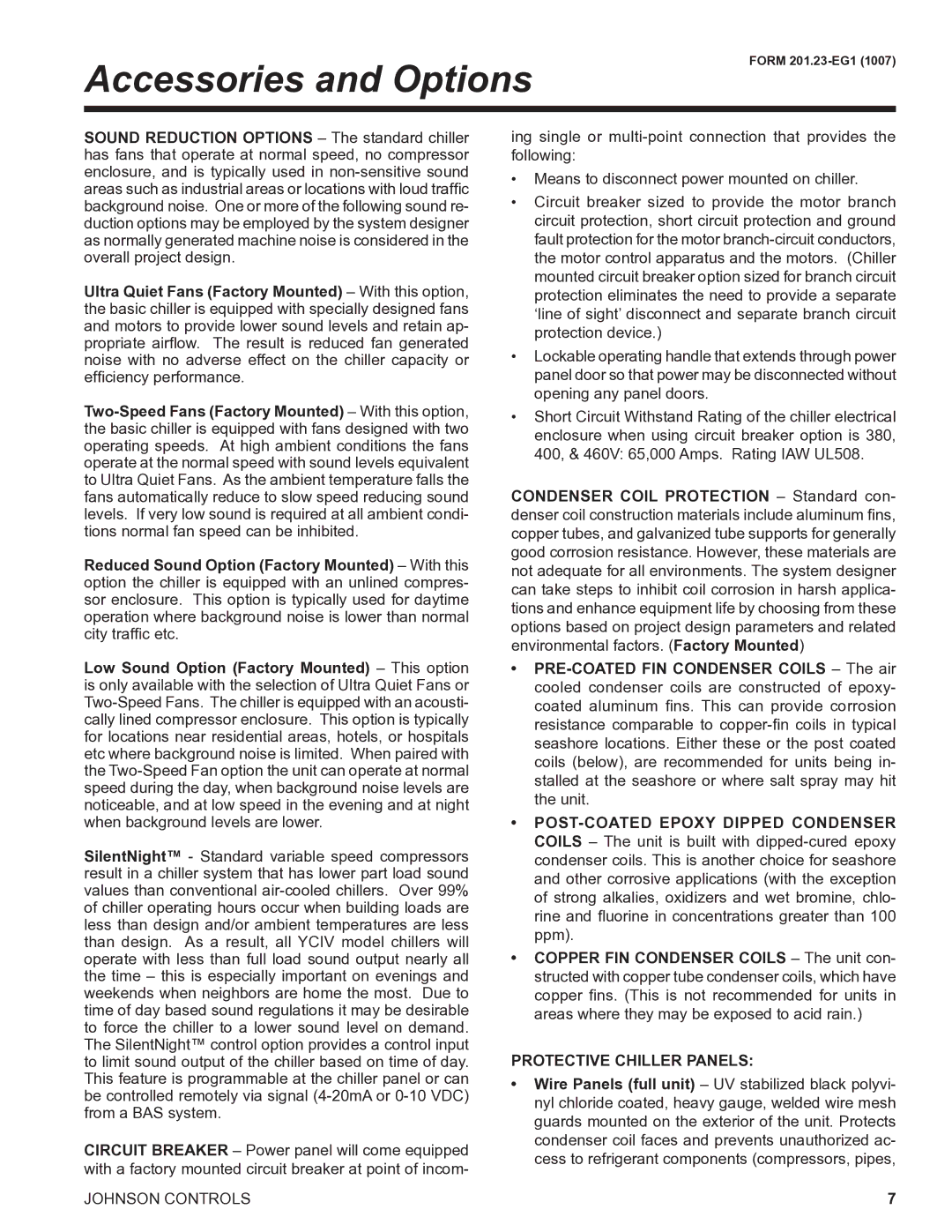SOUND REDUCTION OPTIONS – The standard chiller has fans that operate at normal speed, no compressor enclosure, and is typically used in non-sensitive sound areas such as industrial areas or locations with loud traffic background noise. One or more of the following sound re- duction options may be employed by the system designer as normally generated machine noise is considered in the overall project design.
Ultra Quiet Fans (Factory Mounted) – With this option, the basic chiller is equipped with specially designed fans and motors to provide lower sound levels and retain ap- propriate airflow. The result is reduced fan generated noise with no adverse effect on the chiller capacity or efficiency performance.
Two-Speed Fans (Factory Mounted) – With this option, the basic chiller is equipped with fans designed with two operating speeds. At high ambient conditions the fans operate at the normal speed with sound levels equivalent to Ultra Quiet Fans. As the ambient temperature falls the fans automatically reduce to slow speed reducing sound levels. If very low sound is required at all ambient condi- tions normal fan speed can be inhibited.
Reduced Sound Option (Factory Mounted) – With this option the chiller is equipped with an unlined compres- sor enclosure. This option is typically used for daytime operation where background noise is lower than normal city traffic etc.
Low Sound Option (Factory Mounted) – This option is only available with the selection of Ultra Quiet Fans or Two-Speed Fans. The chiller is equipped with an acousti- cally lined compressor enclosure. This option is typically for locations near residential areas, hotels, or hospitals etc where background noise is limited. When paired with the Two-Speed Fan option the unit can operate at normal speed during the day, when background noise levels are noticeable, and at low speed in the evening and at night when background levels are lower.
SilentNight™ - Standard variable speed compressors result in a chiller system that has lower part load sound values than conventional air-cooled chillers. Over 99% of chiller operating hours occur when building loads are less than design and/or ambient temperatures are less than design. As a result, all YCIV model chillers will operate with less than full load sound output nearly all the time – this is especially important on evenings and weekends when neighbors are home the most. Due to time of day based sound regulations it may be desirable to force the chiller to a lower sound level on demand. The SilentNight™ control option provides a control input to limit sound output of the chiller based on time of day. This feature is programmable at the chiller panel or can be controlled remotely via signal (4-20mA or 0-10 VDC) from a BAS system.
CIRCUIT BREAKER – Power panel will come equipped with a factory mounted circuit breaker at point of incom-
JOHNSON CONTROLS
ing single or multi-point connection that provides the following:
•Means to disconnect power mounted on chiller.
•Circuit breaker sized to provide the motor branch circuit protection, short circuit protection and ground fault protection for the motor branch-circuit conductors, the motor control apparatus and the motors. (Chiller mounted circuit breaker option sized for branch circuit protection eliminates the need to provide a separate ‘line of sight’ disconnect and separate branch circuit protection device.)
•Lockable operating handle that extends through power panel door so that power may be disconnected without opening any panel doors.
•Short Circuit Withstand Rating of the chiller electrical enclosure when using circuit breaker option is 380, 400, & 460V: 65,000 Amps. Rating IAW UL508.
CONDENSER COIL PROTECTION – Standard con denser coil construction materials include aluminum fins, copper tubes, and galvanized tube supports for generally good corrosion resistance. However, these materials are not adequate for all environments. The system designer can take steps to inhibit coil corrosion in harsh applica tions and enhance equipment life by choosing from these options based on project design parameters and related environmental factors. (Factory Mounted)
•PRE-COATED FIN CONDENSER COILS – The air cooled condenser coils are constructed of epoxy- coated aluminum fins. This can provide corrosion resistance comparable to copper-fin coils in typical seashore locations. Either these or the post coated coils (below), are recommended for units being in- stalled at the seashore or where salt spray may hit the unit.
•POST-COATED EPOXY DIPPED CONDENSER COILS – The unit is built with dipped-cured epoxy condenser coils. This is another choice for seashore and other corrosive applications (with the exception of strong alkalies, oxidizers and wet bromine, chlo rine and fluorine in concentrations greater than 100 ppm).
•COPPER FIN CONDENSER COILS – The unit con- structed with copper tube condenser coils, which have copper fins. (This is not recommended for units in areas where they may be exposed to acid rain.)
PROTECTIVE CHILLER PANELS:
•Wire Panels (full unit) – UV stabilized black polyvi- nyl chloride coated, heavy gauge, welded wire mesh guards mounted on the exterior of the unit. Protects condenser coil faces and prevents unauthorized ac- cess to refrigerant components (compressors, pipes,
